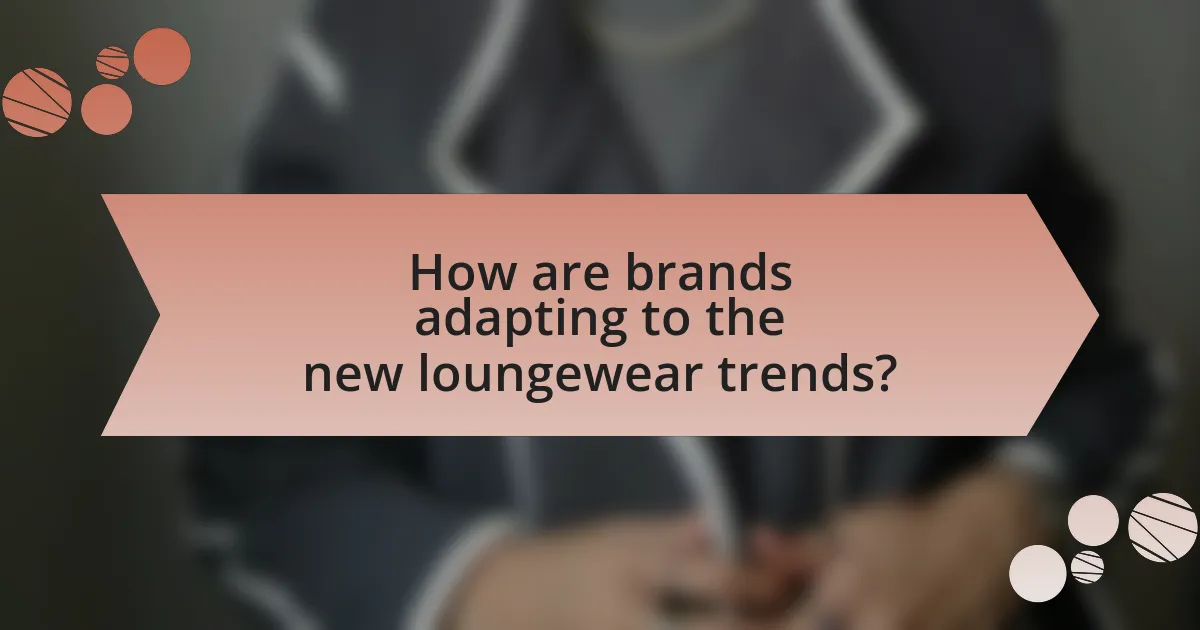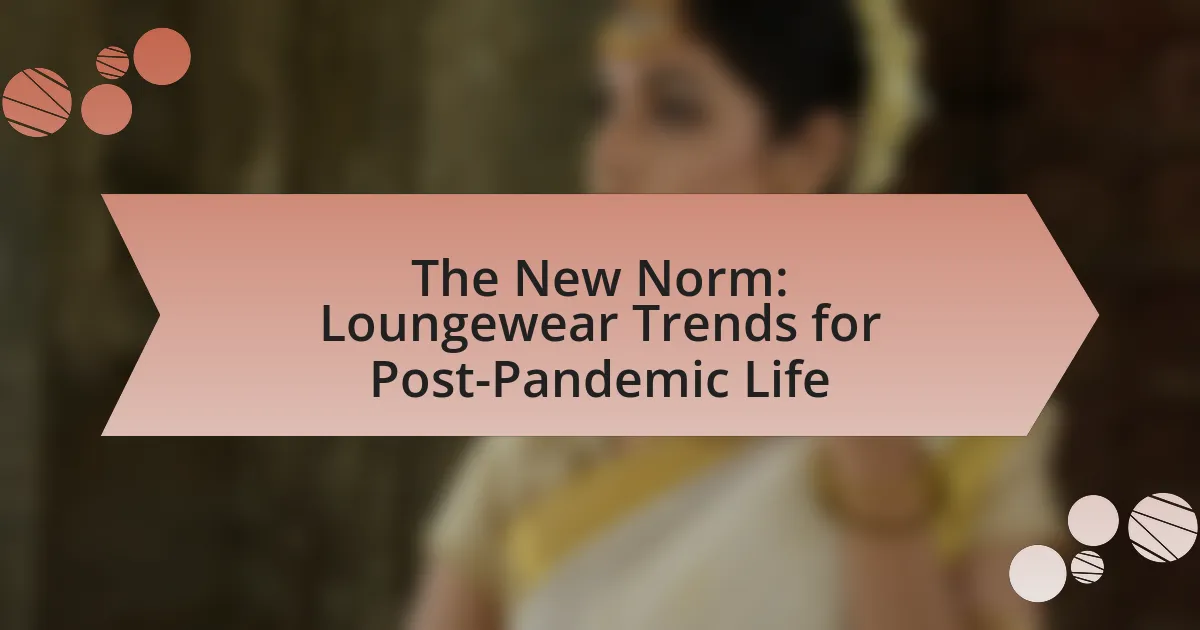The article focuses on the emerging loungewear trends in post-pandemic life, highlighting key aspects such as comfort, versatility, and sustainability. It discusses how the pandemic has shifted consumer preferences towards relaxed fits and multifunctional clothing suitable for both home and casual outings, with a notable rise in athleisure. The piece also examines popular materials like cotton and bamboo, the influence of sustainable practices on purchasing decisions, and how brands are adapting to these trends through innovative designs and effective marketing strategies. Additionally, it provides insights into the evolving styles and practical tips for selecting and caring for loungewear.

What are the key loungewear trends emerging in post-pandemic life?
Key loungewear trends emerging in post-pandemic life include an emphasis on comfort, versatility, and sustainability. Consumers are increasingly favoring relaxed fits, soft fabrics, and multifunctional pieces that can transition from home to casual outings. The rise of athleisure continues, with brands integrating performance materials into everyday wear. Additionally, there is a growing demand for eco-friendly materials and ethical production practices, reflecting a heightened awareness of sustainability among consumers. According to a report by McKinsey & Company, 67% of consumers are more concerned about sustainability than they were before the pandemic, influencing their purchasing decisions in loungewear.
How has the pandemic influenced loungewear choices?
The pandemic has significantly influenced loungewear choices by increasing demand for comfortable, versatile clothing suitable for both home and casual outings. As remote work and social distancing became the norm, consumers prioritized comfort over traditional fashion, leading to a surge in sales of sweatpants, hoodies, and matching sets. According to a report by McKinsey & Company, loungewear sales grew by 30% in 2020, reflecting a shift in consumer preferences towards relaxed styles that accommodate both leisure and work-from-home environments.
What styles have gained popularity during the pandemic?
Loungewear styles have gained significant popularity during the pandemic. The shift towards remote work and social distancing led to increased demand for comfortable clothing, with items such as sweatpants, hoodies, and matching sets becoming staples in everyday wardrobes. According to a report by Edited, loungewear sales surged by 200% in 2020, highlighting the trend’s impact on consumer behavior. This preference for comfort over traditional formal wear reflects a broader cultural shift towards prioritizing ease and relaxation in daily life.
How have consumer preferences shifted towards comfort and functionality?
Consumer preferences have increasingly shifted towards comfort and functionality, particularly in the context of loungewear trends following the pandemic. This shift is evidenced by a significant rise in demand for athleisure and casual wear, as consumers prioritize ease of movement and comfort in their clothing choices. According to a report by McKinsey & Company, 67% of consumers now prefer comfortable clothing over traditional formal attire, reflecting a broader cultural change towards valuing practicality and relaxation in daily life. This trend has led brands to innovate by incorporating versatile designs and functional materials, catering to the growing desire for garments that can seamlessly transition from home to outdoor settings.
What materials are trending in loungewear for the new norm?
Cotton, modal, and bamboo are trending materials in loungewear for the new norm. Cotton is favored for its breathability and comfort, making it ideal for relaxed home settings. Modal, a semi-synthetic fiber made from beech trees, offers a soft feel and moisture-wicking properties, enhancing comfort during extended wear. Bamboo fabric is gaining popularity due to its sustainability and natural antibacterial qualities, appealing to eco-conscious consumers. These materials align with the growing demand for comfort and functionality in loungewear, reflecting lifestyle changes post-pandemic.
Which fabrics are preferred for comfort and breathability?
Cotton and linen are preferred fabrics for comfort and breathability. Cotton is known for its softness and moisture-wicking properties, making it ideal for casual wear and loungewear. Linen, derived from the flax plant, is highly breathable and has natural temperature-regulating qualities, which enhance comfort in warm conditions. Both fabrics allow air circulation, reducing sweat and promoting a comfortable wearing experience, particularly in relaxed settings that have gained popularity in post-pandemic life.
How do sustainable materials play a role in current loungewear trends?
Sustainable materials significantly influence current loungewear trends by prioritizing eco-friendliness and ethical production. Brands are increasingly using organic cotton, recycled polyester, and Tencel, which reduce environmental impact and appeal to environmentally conscious consumers. For instance, a report by McKinsey & Company highlights that 67% of consumers consider sustainability when making fashion purchases, indicating a strong market demand for sustainable loungewear options. This shift not only aligns with consumer values but also encourages brands to innovate in material sourcing and manufacturing processes, thus shaping the future of loungewear.
What are the most popular loungewear styles for different occasions?
The most popular loungewear styles for different occasions include matching sets, oversized sweatshirts, joggers, and athleisure outfits. Matching sets, often made from soft fabrics, provide a coordinated look suitable for casual outings or working from home. Oversized sweatshirts are favored for their comfort and versatility, making them ideal for lounging or running errands. Joggers, with their elastic waistbands and tapered legs, are popular for both relaxation and light exercise, appealing to those seeking comfort without sacrificing style. Athleisure outfits, which blend athletic wear with casual fashion, are increasingly worn for social gatherings and outdoor activities, reflecting a trend towards functional yet stylish clothing. These styles have gained traction as people prioritize comfort and practicality in their wardrobes post-pandemic.
How can loungewear be styled for remote work settings?
Loungewear can be styled for remote work settings by combining comfort with professionalism. Opting for tailored joggers paired with a fitted top creates a polished yet relaxed look suitable for video calls. Incorporating layers, such as a structured blazer over a soft t-shirt, enhances the outfit’s sophistication while maintaining comfort. Accessories like simple jewelry or a stylish watch can elevate the overall appearance, making it more work-appropriate. Studies show that dressing well, even in a remote setting, can boost productivity and improve mood, reinforcing the importance of thoughtful loungewear styling.
What loungewear options are suitable for social gatherings?
Loungewear options suitable for social gatherings include stylish joggers, chic sweatshirts, and coordinated sets that combine comfort with a polished look. These pieces allow individuals to maintain a relaxed vibe while still appearing put-together. For instance, tailored joggers paired with a fitted top can create a balanced outfit that is both comfortable and appropriate for casual meet-ups. Additionally, matching loungewear sets, which have gained popularity, offer a cohesive appearance that is ideal for social interactions. The rise of athleisure has also influenced these choices, making it acceptable to wear elevated activewear in social settings.

How are brands adapting to the new loungewear trends?
Brands are adapting to new loungewear trends by incorporating versatile designs that blend comfort with style, catering to the increased demand for clothing suitable for both home and social settings. This shift is evidenced by major retailers expanding their loungewear collections to include elevated fabrics, tailored fits, and fashionable details, allowing consumers to transition seamlessly from relaxation to socialization. For instance, a report from Edited in 2021 highlighted a 50% increase in loungewear sales compared to pre-pandemic levels, indicating a sustained consumer interest in these styles.
What strategies are brands using to market loungewear effectively?
Brands are effectively marketing loungewear by leveraging social media influencers, emphasizing comfort and versatility, and creating targeted online campaigns. Social media influencers, particularly in fashion and lifestyle sectors, showcase loungewear in relatable settings, which increases brand visibility and consumer engagement. Additionally, brands highlight the comfort and versatility of loungewear, appealing to consumers’ desire for clothing that suits both home and casual outings. Targeted online campaigns utilize data analytics to reach specific demographics, ensuring that marketing efforts resonate with the intended audience. These strategies have proven effective as the loungewear market has seen significant growth, with a report from Grand View Research indicating a projected market size of $60.5 billion by 2027, reflecting the ongoing demand for comfortable clothing in a post-pandemic world.
How are collaborations influencing loungewear collections?
Collaborations are significantly influencing loungewear collections by merging diverse design aesthetics and expanding market reach. For instance, partnerships between high-fashion brands and streetwear labels have led to innovative loungewear pieces that blend luxury with comfort, appealing to a broader audience. A notable example is the collaboration between Adidas and designer Stella McCartney, which resulted in eco-friendly loungewear that emphasizes sustainability while maintaining style. This trend not only enhances brand visibility but also drives consumer interest, as seen in the increased sales of collaborative collections, which often sell out quickly due to their limited availability and unique designs.
What role does social media play in promoting loungewear trends?
Social media significantly influences the promotion of loungewear trends by providing a platform for brands and influencers to showcase their products to a wide audience. Through visually-driven platforms like Instagram and TikTok, users are exposed to various loungewear styles, often leading to viral trends that encourage consumer purchases. For instance, a study by the American Psychological Association found that 70% of consumers are influenced by social media when making fashion choices, highlighting the effectiveness of these platforms in shaping trends. Additionally, user-generated content and influencer partnerships create a sense of community and authenticity, further driving interest and sales in loungewear.
How are pricing strategies changing in the loungewear market?
Pricing strategies in the loungewear market are shifting towards more value-based pricing and dynamic pricing models. This change is driven by increased consumer demand for comfort and versatility in clothing, particularly post-pandemic, where loungewear has become a staple in everyday wardrobes. Brands are now focusing on offering premium quality at competitive prices, often utilizing data analytics to adjust prices based on consumer behavior and market trends. For instance, a report from McKinsey & Company indicates that brands that adopt flexible pricing strategies can better respond to fluctuations in demand, enhancing their market position.
What factors are influencing the pricing of loungewear items?
The pricing of loungewear items is influenced by factors such as material quality, brand reputation, production costs, and market demand. High-quality materials like organic cotton or sustainable fabrics typically lead to higher prices due to increased production costs and consumer willingness to pay for sustainability. Brand reputation also plays a significant role; established brands can command higher prices based on perceived value and consumer loyalty. Additionally, production costs, including labor and manufacturing processes, directly affect pricing, as brands must cover these expenses while maintaining profit margins. Finally, market demand, particularly during periods of increased remote work and casual dressing trends, can drive prices up as consumers seek comfortable and stylish options.
How do consumers perceive value in loungewear purchases?
Consumers perceive value in loungewear purchases primarily through comfort, versatility, and quality. Comfort is a significant factor, as many consumers prioritize soft, breathable fabrics that enhance relaxation during home activities. Versatility adds to perceived value, with consumers appreciating loungewear that can transition from home to casual outings, reflecting a shift in lifestyle preferences post-pandemic. Quality also plays a crucial role; consumers are willing to invest in durable materials that withstand frequent wear, as evidenced by a 2021 survey indicating that 70% of respondents consider fabric quality essential in their purchasing decisions. This combination of comfort, versatility, and quality shapes how consumers evaluate the overall value of loungewear.

What are the future predictions for loungewear trends?
Future predictions for loungewear trends indicate a continued emphasis on comfort, versatility, and sustainability. As remote work remains prevalent, consumers are expected to favor loungewear that seamlessly transitions from home to casual outings, incorporating stylish yet comfortable designs. Additionally, the rise in eco-consciousness will drive demand for sustainable materials and ethical production practices in loungewear collections. Market research shows that the global loungewear market is projected to grow significantly, with a compound annual growth rate of over 6% from 2021 to 2028, reflecting the ongoing shift in consumer preferences towards relaxed and functional apparel.
How might loungewear evolve in the next few years?
Loungewear is likely to evolve towards more versatile and functional designs in the next few years. As remote work continues to influence daily routines, consumers will seek loungewear that seamlessly transitions from home to casual outings. This trend is supported by a 2021 report from McKinsey, which indicated a 30% increase in demand for comfortable clothing that combines style with practicality. Additionally, advancements in fabric technology will lead to the incorporation of sustainable materials and smart textiles, enhancing comfort and functionality. The rise of athleisure and the blending of loungewear with activewear further exemplify this evolution, as consumers prioritize both comfort and aesthetic appeal in their clothing choices.
What emerging trends should consumers watch for in loungewear?
Emerging trends in loungewear that consumers should watch for include increased demand for sustainable materials, multifunctional designs, and elevated aesthetics. The shift towards sustainability is driven by consumer awareness of environmental issues, leading brands to adopt eco-friendly fabrics like organic cotton and recycled polyester. Multifunctional designs, such as pieces that transition from home to casual outings, reflect the growing preference for versatility in clothing. Additionally, elevated aesthetics, characterized by stylish yet comfortable designs, are becoming popular as consumers seek to balance comfort with fashion, particularly in the context of remote work and social activities. These trends are supported by market research indicating a significant rise in loungewear sales, with the global loungewear market projected to reach $20 billion by 2027, highlighting the ongoing evolution of consumer preferences in this category.
How will lifestyle changes continue to shape loungewear preferences?
Lifestyle changes will continue to shape loungewear preferences by increasing demand for comfort, versatility, and sustainability. As remote work and hybrid models become more prevalent, consumers prioritize clothing that allows for ease of movement and adaptability between home and social settings. A survey by McKinsey & Company found that 67% of consumers prefer comfortable clothing, indicating a shift towards loungewear that can be worn in various contexts. Additionally, the growing awareness of environmental issues drives consumers to seek sustainable materials and ethical production practices in their loungewear choices. This combination of comfort, versatility, and sustainability will define future loungewear trends.
What practical tips can help consumers choose the right loungewear?
To choose the right loungewear, consumers should prioritize comfort, fit, and fabric. Comfort is essential, as loungewear is typically worn for relaxation; therefore, selecting soft materials like cotton or modal enhances the experience. Fit is also crucial; consumers should opt for styles that allow for ease of movement without being overly baggy, ensuring a balance between comfort and a polished look. Additionally, considering the fabric’s breathability and stretch can significantly impact wearability, especially for extended periods at home. According to a survey by the NPD Group, 70% of consumers prefer loungewear that combines comfort with style, highlighting the importance of these factors in making informed choices.
How can one balance comfort and style in loungewear selections?
To balance comfort and style in loungewear selections, prioritize fabrics that offer both softness and breathability, such as cotton or modal blends. These materials provide the necessary comfort for relaxation while allowing for stylish designs, like tailored joggers or chic oversized sweaters. Research indicates that consumers increasingly favor versatile loungewear that can transition from home to casual outings, reflecting a trend where 70% of individuals prefer clothing that combines comfort with aesthetic appeal. By selecting pieces that feature modern cuts and fashionable details, one can achieve a polished look without sacrificing comfort.
What are the best practices for caring for loungewear items?
The best practices for caring for loungewear items include washing them in cold water, using a gentle detergent, and avoiding fabric softeners to maintain their softness and elasticity. Washing loungewear in cold water helps prevent shrinkage and color fading, while gentle detergents are less harsh on the fabric, preserving its quality. Additionally, air drying loungewear instead of using a dryer prevents damage from high heat, which can lead to wear and tear. Following these practices ensures that loungewear remains comfortable and retains its shape over time.
